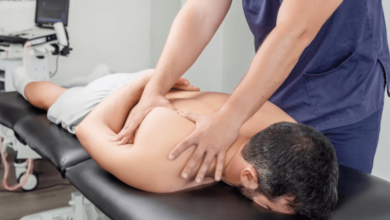Self-Massage Techniques You Can Do at Home for Instant Relief

Self-massage is an excellent way to relieve stress, ease muscle tension, and even promote better blood circulation—all from the comfort of your home. Whether you’re battling neck pain after a long day at your desk, dealing with tight muscles from a workout, or just seeking some relaxation, self-massage is a simple, effective solution that can provide instant relief. In this article, we’ll explore various self-massage techniques you can incorporate into your daily routine for immediate comfort.
What is Self-Massage?
Self-massage is the act of using your hands or specialized tools to manipulate your body’s muscles and soft tissues. By applying pressure and rhythmic movements, you can release muscle tension, reduce pain, and improve circulation. It’s a natural way to enhance your 오피스타 well-being and is commonly used to address sore muscles, stress, or general discomfort without the need for expensive treatments or equipment.
Why You Should Consider Self-Massage
Self-massage is not just about feeling good—it has several scientifically-backed benefits that promote physical and mental health. Here’s why you should consider adding it to your routine:
- Stress Relief and Relaxation: Self-massage is incredibly effective at reducing stress. By targeting key tension points, you can feel more relaxed and calm.
- Muscle Recovery and Pain Relief: After a long workout or a day of physical activity, self-massage can help relieve sore muscles, promote recovery, and ease pain.
- Enhanced Blood Circulation: Applying pressure on certain areas can improve circulation, which helps in the delivery of oxygen and nutrients to muscles and organs.
Self-Massage Techniques for Instant Relief
Now that we understand the benefits, let’s dive into the specific self-massage techniques that can provide instant relief. Each technique is easy to perform at home and doesn’t require special training or equipment.
Technique 1: Neck and Shoulder Massage
The neck and shoulders are common areas where tension accumulates, especially if you spend a lot of time sitting at a desk or working on a computer. To relieve discomfort, use your fingers to gently knead the muscles at the back of your neck and the tops of your shoulders. Apply circular motions or press down firmly for about 30 seconds in each area, gradually releasing the tension.
Technique 2: Hand and Wrist Massage
For those who work with their hands or are on the computer all day, hand and wrist pain is common. Use your thumb to apply gentle pressure along the palms and wrists, focusing on any sore spots. You can also gently pull and stretch your fingers to relieve stiffness. This quick and easy massage can be done several times throughout the day.
Technique 3: Foot Massage
Your feet carry the weight of your body all day, so they deserve some care too. To give them a quick refresh, start by rubbing the soles with your thumbs, working your way from the heel to the toes. Applying pressure on the arch of your foot can also help relieve tension. If you have a tennis ball, you can roll it under your feet for added relief.
Technique 4: Back Massage with a Foam Roller
Using a foam roller on your back is a great way to release tightness and improve spinal alignment. Lie on your back, placing the foam roller beneath your upper back. Slowly roll up and down the spine, pausing on any tender spots. This technique can be especially helpful after a workout or a long day of sitting.
Technique 5: Scalp Massage
A soothing scalp massage can work wonders for reducing stress and even promoting hair growth. Using your fingertips, gently rub your scalp in circular motions, applying a little pressure. You can also use an oil like coconut oil for extra hydration. Try this for 5-10 minutes for immediate relaxation.
Technique 6: Lower Back and Hip Massage
Lower back pain is a common issue for many people. To relieve this, use your thumbs to press into the muscles of your lower back and hips. Apply pressure and use circular motions to work out tightness in these areas. You can also lie on your back and use a tennis ball to target specific areas.
Technique 7: Face and Jaw Massage
If you suffer from jaw pain, tension, or headaches, a face and jaw massage can provide instant relief. Use your fingers to gently massage the sides of your jaw, moving up to your temples. You can also apply pressure to the area between your eyebrows for a calming effect.
How to Maximize Your Self-Massage Experience
To make the most of your self-massage, consider these tips:
- Create the Right Environment: Choose a quiet space where you can relax without distractions. You may want to play calming music, light a candle, or even use essential oils for added relaxation.
- Use the Right Tools: If you prefer to use tools, there are many options available, such as foam rollers, massage balls, or handheld massagers. These tools can help you apply pressure in hard-to-reach places.
- Go Slow: Don’t rush through your massage. Give yourself time to really focus on each area, allowing the tension to gradually melt away.
When to Seek Professional Help
While self-massage can be incredibly effective, there are times when professional help may be necessary. If you experience persistent pain, numbness, or tingling, or if you have a medical condition like arthritis or fibromyalgia, it’s essential to consult with a healthcare provider. A professional massage therapist can provide targeted treatments that may be more effective for chronic conditions.
Common Mistakes to Avoid
When practicing self-massage, avoid these common mistakes:
- Overdoing It: While it’s tempting to apply a lot of pressure, especially on tight muscles, be gentle. Excessive pressure can cause bruising or injury.
- Using Incorrect Pressure: Make sure you’re using the right amount of pressure for the area you’re working on. Light pressure works for sensitive areas, while deeper pressure is better for large muscle groups.
FAQs
How long should I spend on self-massage?
A self-massage session typically lasts 10-20 minutes, depending on the area you’re focusing on.
Can self-massage be done every day?
Yes, you can perform self-massage daily to maintain relaxation and muscle health. However, it’s important to listen to your body and avoid overdoing it.
What are the best tools for self-massage?
Popular tools include foam rollers, massage balls, handheld massagers, and even tennis balls. Choose what works best for your needs.
Are there any health conditions where self-massage is not recommended?
If you have certain conditions like deep vein thrombosis, severe arthritis, or broken bones, avoid self-massage. Always consult a doctor if unsure.
How can I relieve tension in my neck and shoulders quickly?
A quick self-massage with gentle kneading, along with stretching, can help alleviate neck and shoulder tension effectively.
Does self-massage improve sleep quality?
Yes, by reducing muscle tension and promoting relaxation, self-massage can contribute to better sleep quality.
Conclusion
Self-massage is a simple yet powerful way to achieve instant relief from stress, tension, and pain right at home. By incorporating these techniques into your daily routine, you can enjoy the benefits of a professional massage without the high cost or time commitment. Whether you’re targeting sore muscles or simply looking to unwind, self-massage can help restore your body and mind to a state of relaxation.







